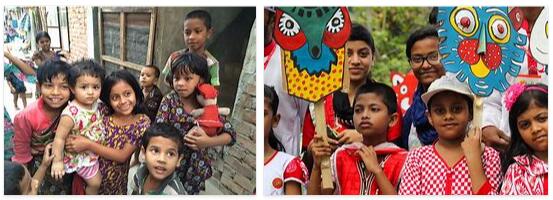From 1990 to 2012, infant mortality in the world was almost halved; it went down from 12.6 million to 6.6 million. However, 18,000 children still die every day before the age of five. Bangladesh is an exceptional case: the country has managed to reduce child mortality significantly in a few decades, despite the fact that the country is very poor and struggling with major challenges.
- What is high – or low – infant mortality often a measure of?
- Why is Bangladesh highlighted?
- How can we explain the decline in child mortality in Bangladesh?
- What experiences from Bangladesh can other developing countries benefit from?
In February 2014, the medical journal The Lancet released a report on infant mortality in Bangladesh . The report shows that the annual number of children under the age of five who die has almost halved between 1990 and 2010. This report describes this decline in child mortality as exceptional. Despite economic growth in recent years, the country is still poor in lye, and the health system is weak and poorly developed. Like other countries in South Asia, the percentage of malnourished women and children is among the highest in the world.
2: What is infant mortality?
Child mortality is a measure of children’s survival and reflects the social, economic and environmental conditions in which children live. Mortality for children under the age of five is considered to be one of the clearest indicators of a country’s welfare. Reducing child mortality is therefore not only about expanding health services, but also about improving children’s living conditions.
Child mortality as a measure refers to mortality among infants and children under five years of age. These first years of life are the period in life where physical and mental health are most affected by living conditions and the environment . Research has shown that children who experience difficult upbringing conditions have greater morbidity (more and more severe diseases) and higher mortality (greater probability of premature death) than children of the same age with good upbringing conditions.
Most children in developing countries die from diseases such as diarrhea, measles or pneumonia , which can be prevented or treated with simple and affordable means . Malnutrition is often an underlying cause of many of the deaths. Malnutrition or malnutrition is again closely linked to access to food and the quality of the food one eats. Lack of clean water and poor sanitation are the second most important cause of illness and death in children after malnutrition.
Most children die at home, without access to vital medicines and health care. The health of women and children is closely linked. Almost 20 percent of deaths among children under the age of five are due to complications or infections just before, during or just after birth. Reducing this mortality requires a comprehensive health service that is able to take care of both mother and child around birth. To further reduce child mortality, according to HEALTHINCLUDE.COM, Bangladesh must promote measures that reduce the risk of disease and increase the potential for good health in children.
In Norway, we prevent through everything from vaccination programs, urban planning, food and school policy. And we have a good health system that ensures access to health services when we become ill. Many will also claim that it seems preventive that Norwegian policy is designed not to allow too great inequality between groups in society. The negative health effects of a policy that creates increasing economic inequalities between population groups are clear, both in poor and rich countries.
The work with public health and child health is complex . It is hard work on many levels and extends across many sectors of society. We have long believed that economic growth is what is needed. But economic growth in itself does not lead to better public health. Without a fair distribution policy, it is not a given that economic growth benefits everyone. In the last couple of decades, many actors have also argued that increased aid to the poorest countries is necessary. Poor countries alone cannot bear all the costs associated with welfare and necessary health services. But it is also clear that development assistance in itself does not achieve results without a clear and nationally based policy. Here, many countries can learn from Bangladesh .









